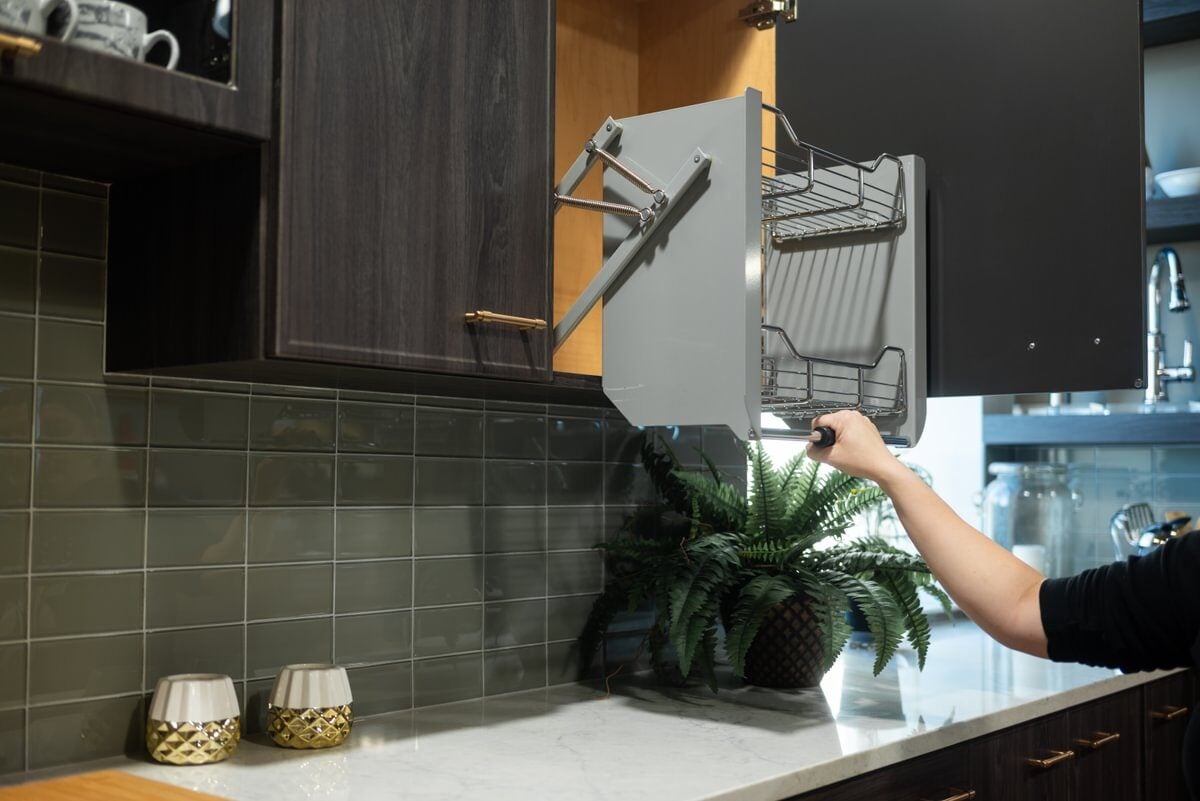More and more homeowners want to create kitchens that are truly sustainable. When deciding to use a green approach, they especially aim for kitchen remodeling companies that offer automatically sustainable and inherently durable options that minimize the exploitation of Mother Earth's resources.
Choosing environmentally conscious solutions when renovating doesn’t just shrink your footprint, it also means stylish, practical, and cost-effective upgrades. In order to help you learn more about the ways in which you can design an environmentally-safe kitchen and cooking area for yourself and your family, we’ve gathered several extremely useful tips.
How can I make my kitchen environmentally friendly?
Sustainable kitchen design comes down to smart choices in materials, appliances, and daily habits. From the cabinets you install to the light bulbs you use, every decision can reduce waste, save energy, and create a healthier space for your family. The good news is that you don’t have to do everything at once, because even small upgrades can make a big difference. Here are some of the best ways to design a kitchen that’s both beautiful and sustainable:

1. Refacing cabinetry is always a great solution
In almost all cases, refacing cabinets will deliver the same look as custom cabinetry while it uses less than a single tree’s worth of wood. Thanks to the reinforcement process, your existing cabinets end up with stronger, more durable boxes. You’ll save money too, since refaced cabinets often cost less than half of an all-new custom-designed kitchen.
If you’re keeping your kitchen layout more or less the same, refacing is an eco-conscious choice that gives you the results you want without dragging you through a long planning phase. It’s a smart way to refresh your kitchen while cutting down on waste, since it reuses the sturdy structure of your existing cabinets instead of replacing them entirely. To complement your refaced cabinets, you can bring in sustainable design elements like recycled glass or reclaimed wood for shelving and accents. Decorative touches such as earth-friendly tiles or vintage hardware add character while keeping sustainability front and center. By choosing cabinet refacing and thoughtful recycled materials, you’ll end up with a stylish makeover that’s both beautiful and environmentally responsible.
But, not everyone is suited for this path. You'll have to determine if refacing is the viable choice for you. If you have questions, speak with your Kitchen Magic design consultant and ask them what qualifiers are needed for a kitchen to be a good refacing candidate and to present you with some before and after photos to help you make the right determination.
2. Smart new cabinetry
When choosing new cabinetry, the quality of the material makes all the difference. North American plywood is a reliable option because by and large it comes from responsibly managed forests designed to stay renewable. These forests are carefully maintained, providing sustainable resources while also supporting the families and communities who depend on them.

3. Quartz or Corian countertops are environmentally safe materials
Both products are considered more sustainable than granite countertops. If we’re comparing quartz, Corian, and granite, the production of quartz and Corian has less impact than the mining required for granite (not a renewable resource by any means). When you add their virtually maintenance-free qualities, along with the fact that they don't require toxic sealants and will last a lifetime without cracking or chipping—quartz and Corian are the lasting choice for your countertops. Plus, brands such as Viatera quartz, Corian and Hi-Macs solid surface incorporate varying levels of recycled materials in their manufacturing process)
4. Energy-efficient kitchen lighting, fixtures, and appliances
The good news is that energy efficiency is a serious priority in our culture today. Look for an HVAC system or appliances and lighting fixtures that have the Energy Star symbol to ensure they exceed current EPA guidelines for energy efficiency. Be sure your plumbing fixtures have the WaterSense label as well.
Adding dimmer switches to lights allows you to adjust the wattage. You decide when it should be brighter and save some energy in the process. Likewise, when you do replace your bulbs use eco-friendly LED bulbs wherever you can. They are more expensive at the outset but last longer so you get that money back via energy savings and fewer lifetime replacements.
While you're at it, choose one of the great sink upgrade options and turn your faucets to touch-free. Not only is it convenient and easy to use but you're minimizing water waste with automatic shut-off. Go green with these little changes and you will be making a difference.

How can I maximize natural light in my kitchen while maintaining energy efficiency?
To bring more natural light into your kitchen, add larger windows or skylights, swap heavy curtains for sheer or minimal treatments, and use light colors on cabinets or walls. Reflective surfaces like glass or glossy tiles can bounce sunlight around, while open shelving helps light flow through the space.
5. Choose low to no-VOC finishes
Finally, off-gassing—the release of volatile organic chemicals (VOC)—compromises both outdoor and indoor air quality. A true, green kitchen will have finishes that are low or zero-VOC, which minimizes pollution all around. Be sure to inquire about possible ways to improve the indoor air quality inside your kitchen as you work through the design process.
6. Eco-conscious furniture & décor
Furniture and décor are often overlooked, but they have a huge impact on sustainability. Dining tables and chairs made from reclaimed or FSC-certified wood are smart, responsible choices. Upcycled or second-hand décor adds charm while cutting down on the demand for new materials. Taking a minimalist approach, such as choosing timeless designs and fewer, higher-quality pieces, helps reduce waste while keeping the space stylish and inviting.
7. Water conservation
Conserving water in the kitchen is easier than most people think. Adding faucet aerators reduces water flow without affecting performance, and greywater systems that recycle lightly used water from sinks or dishwashers are becoming more common in sustainable homes. Even simple habits, like only running the dishwasher when it’s full or fixing leaks right away, make a big difference in cutting down unnecessary waste.
Image
8. Lifestyle habits for a greener space
Even the best sustainable design only works if it’s backed by good daily habits. Simple swaps like trading plastic storage for glass containers, stainless steel, or beeswax wraps help cut down on waste. Choosing non-toxic cleaning products keeps harmful chemicals out of your home and waterways. And practicing a zero-waste approach to cooking, from planning meals and composting scraps to storing food properly, keeps your routine both practical and planet-friendly.
9. Waste reduction & recycling systems
A sustainable kitchen should make handling waste feel effortless. With features like built-in compost bins and pull-out recycling stations, it’s simple to cut down on single-use plastics and move toward a zero-waste lifestyle.
Image
10. Budgeting & long-term value
Sustainable interior design doesn’t have to be expensive. Simple upgrades, like switching to LED lighting, adding faucet aerators, or using low-VOC paints, are affordable and easy to put in place. Bigger investments, such as energy-efficient appliances, often pay for themselves through lower utility bills. On top of that, many regions offer rebates, grants, or tax incentives for eco-conscious improvements, making green remodeling more attainable than ever.
11. Stunning and purposeful kitchens made from recycled materials
From the products that are recycled into quartz slabs, to the recycled glass that comprises glass tiles, there are plenty of opportunities to style your kitchen using materials manufactured with recycled "ingredients." Keep recycled items in mind for your decor choices. Refurbish and repurpose items where you can—you'll create a stunning design piece while doing your part to help save the earth!

12. A timeless kitchen design
Part of sustainability is longevity. The more you have to re-do or replace, the less sustainable it is because it requires more resources to manufacture replacements. Products may require more toxins to be produced in order to paint, finish or seal it. You also have to consider the fact that you'll be using more fuel for shipping and transporting these items to and from locations.
Designing a sustainable kitchen requires a long-view approach. You want to carefully design a timeless cooking place that will be as comfortable, functional and beautiful now as it will be five, ten and even 20 years from now. Create a kitchen design that shouldn't need any significant work or replacements and will be accessible for everyone in your family.
How to choose sustainable materials for my kitchen?
You can choose sustainable materials for your kitchen by focusing on options that are renewable, responsibly sourced, and safe for your home. These choices make your kitchen healthier, reduce waste, and still give you a beautiful design. Here are some of the best options to consider:
- Bamboo or cork flooring – renewable, durable, and stylish alternatives to traditional hardwood.
- Recycled glass countertops – a modern, sleek surface that reuses materials which might otherwise go to waste.
- Reclaimed wood – adds warmth and character while cutting down on the demand for new lumber.
- Low-VOC paints and finishes – reduce harmful off-gassing, keeping your indoor air cleaner and healthier.
- Certified materials (FSC, etc.) – ensure that wood and other resources are responsibly sourced and sustainable.
What makes Kitchen Magic one of the most reliable remodeling companies?
For us, it starts with responsibility. We’ve made waste reduction part of our everyday process, down to the way we cut materials so nothing goes unused. Even with tricky-to-recycle products, we focus on minimizing impact and maximizing efficiency.
With more than 45 years of hands-on experience, we’ve seen every kind of remodel—big and small. That knowledge helps us deliver spaces that look beautiful, function flawlessly, and last for years. Our designers listen, our craftsmen pay attention to detail, and our materials are chosen with both quality and the planet in mind.
If you’re ready to create a kitchen that’s sustainable, functional, and built around you, schedule an in-home consultation with Kitchen Magic today to learn which options are right for you.











